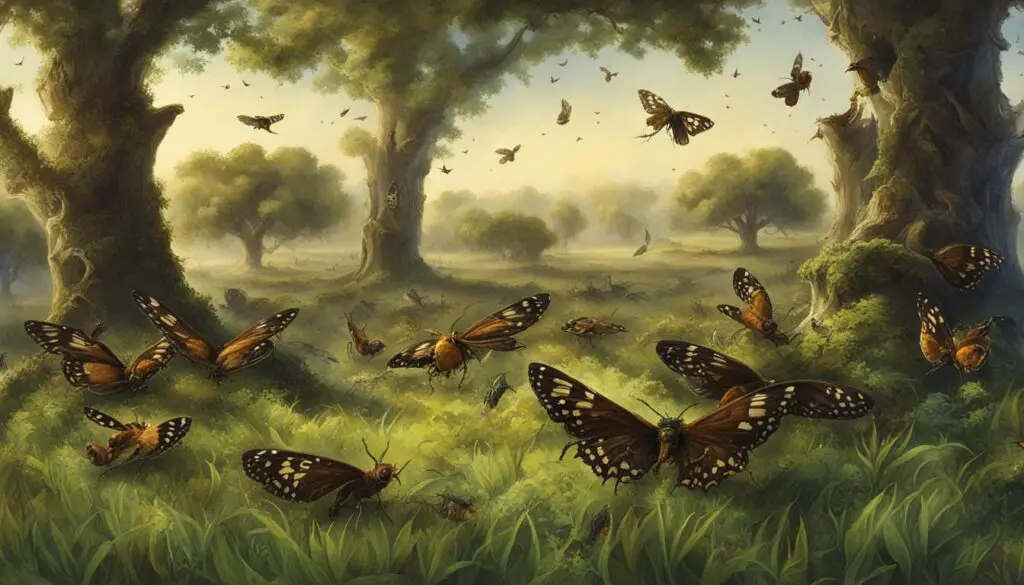Oak trees are not only majestic and iconic, but they also play a vital role in supporting diverse ecosystems. However, these grand trees face various challenges in the form of pests, diseases, and natural predators. Understanding the interactions and dynamics within the oak tree ecosystem is crucial for preserving the health and longevity of these magnificent trees.
In this article, we will explore the key pests and diseases that threaten oak trees, as well as the predators that can impact their overall well-being. From caterpillars and scale insects to common tree diseases, we will delve into the intricacies of the oak tree food chain and the fascinating world of animal interactions within this ecosystem.
Join us as we uncover the secrets of what eats oak trees and the delicate balance that exists within their natural habitat.
Key Takeaways:
- Oak trees face a range of pests and diseases that can threaten their health and growth.
- Caterpillars are common pests that can defoliate oak trees.
- Galls caused by various wasps can impact oak tree health.
- Scale insects feed on plant sap and weaken oak trees.
- Oak trees also have natural predators like the emerald ash borer and gypsy moth.
Common Caterpillar Pests
Caterpillars can pose a significant threat to oak trees, as they have the ability to defoliate and skeletonize leaves, causing serious damage. Two of the most common caterpillar pests that target urban oak trees are the orangestriped oakworm and the forest tent caterpillar.
The orangestriped oakworm, also known as the Anisota senatoria, is a native species found in North America. These caterpillars can quickly consume large quantities of oak tree foliage, leading to the defoliation of affected trees. Their feeding activity can result in stunted growth and moderate dieback if left untreated.
The forest tent caterpillar, scientifically known as the Malacosoma disstria, is another common oak tree defoliator. These caterpillars can be easily recognized by the key identifying feature of a blue stripe running down the center of their back. Forest tent caterpillars can swiftly strip the leaves off oak trees, leaving behind only the skeletal framework of branches and severely impacting their overall health.
Here is a visual representation of the orangestriped oakworm and the forest tent caterpillar:
| Caterpillar Pest | Scientific Name | Ideal Habitat | Feeding Behavior |
|---|---|---|---|
| Orangestriped Oakworm | Anisota senatoria | North America | Rapid defoliation |
| Forest Tent Caterpillar | Malacosoma disstria | Various regions | Complete leaf strip |
Galls and Gall Wasps
Galls are abnormal swelling or growths made of plant tissue that are caused by insects, fungi, nematodes, and other organisms. These peculiar formations can be found on oak trees and are a result of various environmental factors and interactions.
One significant contributor to the formation of oak tree galls is gall wasps. These tiny wasps belong to different species and induce distinct types of galls. Some common gall wasps that affect oak trees include horned oak galls, wool sower galls, and oak apple galls.
Gall wasps lay eggs on oak tree leaves or twigs, triggering the tree to produce abnormal growths or swellings as a defense mechanism to protect itself from these intruders. The larvae of gall wasps develop inside these galls, which provide them with a shelter and a source of food.
The appearance and characteristics of oak tree galls can vary depending on the specific species of gall wasp and the type of tissue they affect. Some galls may have intricate shapes or patterns, resembling horns or fuzzy balls, while others may resemble small apples.

| Gall Types | Description |
|---|---|
| Horned Oak Galls | These galls have distinct horn-like protrusions and are usually found on oak leaves or twigs. They are caused by the gall wasp belonging to the genus Callirhytis. |
| Wool Sower Galls | These galls are spherical or oblong in shape and covered in a wool-like substance. They typically form on oak leaves and are the result of the gall wasp Andricus quercuslanigera. |
| Oak Apple Galls | These galls are round and apple-like, hence the name. They develop mostly on oak twigs and are caused by the gall wasp Amphibolips confluenta. |
Galls can affect the overall health and vigor of oak trees, especially when they occur in large numbers or if the galls interfere with the tree’s ability to photosynthesize effectively. However, it’s important to note that not all galls are harmful or detrimental to oak tree health.
Understanding the different types of galls and the gall wasps that induce them can help arborists and tree enthusiasts better identify and manage potential issues. Proper tree care practices and monitoring can help mitigate any negative impacts caused by gall wasps and ensure the long-term health of oak trees.
Scale Insects
Scale insects are small pests that have a shield-like or waxy covering. These insects can have a significant impact on the health and vitality of oak trees. Two common types of scale insects that affect oak trees are the oak lecanium scale and the obscure scale.
Scale insects feed on the sap of oak trees, which can result in stunted growth, leaf drop, and the overall weakening of the tree. They have a distinct appearance and can often be found on the branches and trunks of oak trees. The waxy covering of scale insects serves as a protective barrier against predators and environmental conditions.
Infestations of scale insects are commonly observed during the summer months when these pests are most active. It is important to monitor oak trees for signs of scale insects and take appropriate measures to manage their population.
Other Insects and Pests
While caterpillars and scale insects are common pests that affect oak trees, there are other insects and pests that can also pose a threat to their health. Let’s take a closer look at some of them:
Oak Leaftier
The oak leaftier is a small moth caterpillar that feeds on oak leaves. It constructs small shelters by tying leaves together with silk and feeds within these structures. Oak leaftiers can cause defoliation and weaken the tree if left uncontrolled.
Oak Leafroller
The oak leafroller is another caterpillar species that feeds on oak leaves. It rolls the leaves to create a protective shelter where it feeds and develops. Severe infestations of oak leafrollers can lead to significant leaf loss and affect the overall health of the tree.
Scarlet Oak Sawfly
The scarlet oak sawfly is a type of non-stinging wasp that primarily feeds on scarlet oak leaves. The larvae of this sawfly can defoliate trees if populations are high. Early detection and appropriate management techniques are crucial in preventing extensive damage.
Spider Mites
Spider mites are tiny arachnids that can infest oak trees and cause damage by piercing the leaf tissue and sucking out the sap. The feeding activity of spider mites can result in yellowing, bronzing, and premature dropping of leaves. Proper identification and prompt treatment are essential in controlling spider mite populations.
To effectively manage oak tree pests, it is important to monitor for signs of infestation and take necessary measures to prevent their proliferation. Integrated pest management (IPM) practices, including the use of biological controls and targeted insecticides, can help protect oak trees and maintain their overall health.

Common Tree Diseases
Oak trees are susceptible to various diseases, including anthracnose, oak tatters, and oak wilt. These diseases can cause leaf discoloration, lacy or tattered leaves, and even death of the tree if not properly managed.
The first common disease that affects oak trees is anthracnose. This fungal disease can cause leaf spots, defoliation, and twig dieback. It thrives in cool, wet spring weather and spreads through infected debris and rain splashes. Anthracnose can weaken the tree, making it more susceptible to other pests and diseases.
The second disease, oak tatters, is characterized by leaves with irregular, tattered edges. It is caused by a combination of environmental factors and genetic abnormalities. The exact cause is not fully understood, but it is believed to be related to insect feeding and environmental stress. Oak tatters does not usually impact the long-term health of the tree, but it can affect its aesthetics.
The third disease, oak wilt, is a serious fungal infection that can quickly kill oak trees. It is caused by the fungus Ceratocystis fagacearum and is primarily spread through root grafts between trees. Oak wilt can also be transmitted by sap-feeding beetles. Infected trees show wilting, browning, and death of leaves, starting at the top of the canopy and progressing downward.
| Disease | Symptoms | Management |
|---|---|---|
| Anthracnose | Leaf spots, defoliation, twig dieback | – Prune affected branches – Improve air circulation – Remove infected debris – Apply fungicides if necessary |
| Oak Tatters | Tattered leaves with irregular edges | – No specific management – Maintain tree’s overall health |
| Oak Wilt | Wilting, browning, death of leaves | – Prevent root grafting – Remove infected trees – Apply fungicides as preventive measure |
Other Diseases and Problems
In addition to the common tree diseases, oak trees can face other diseases and problems that can weaken the tree and impact its overall health. Some of these diseases and problems include:
Dutch Elm Disease:
Dutch Elm Disease is a fungal disease that affects elm trees, but oak trees can also be susceptible to this destructive disease. It is caused by a fungus called Ophiostoma novo-ulmi, which is spread by elm bark beetles. The disease clogs the water-conducting vessels in the tree, leading to wilting, yellowing leaves, and eventual death if left untreated.
Mistletoe Infestation:
Mistletoe is a parasitic plant that can infest oak trees and weaken their overall health. Mistletoe plants grow on the branches of trees and extract nutrients and water from the host tree. This can lead to stunted growth, reduced vitality, and even death in severe cases.
Pine Wilt:
Pine Wilt is a disease that primarily affects pine trees, but it can also infect oak trees. It is caused by the pine wood nematode, a microscopic worm that is spread by pine sawyer beetles. The disease disrupts the tree’s water-conducting vessels, causing wilting, browning of needles, and eventual death.
Oak Decline:
Oak Decline refers to a complex of symptoms that can affect oak trees, leading to the overall decline of the tree’s health and vigor. It is often caused by a combination of factors, including environmental stressors, pests, diseases, and poor soil conditions. Symptoms can include thinning foliage, dieback of branches, and reduced growth.
Addressing and managing these diseases and problems is crucial in maintaining the health and longevity of oak trees. Regular tree inspections, proper pruning, and implementing appropriate control measures can help mitigate the impact of these issues.
“Addressing and managing these diseases and problems is crucial in maintaining the health and longevity of oak trees.”
Oak Tree Predators
Oak trees are not only vulnerable to pests and diseases but also have their fair share of natural predators. Two notable predators that can cause damage to oak trees are the emerald ash borer and the gypsy moth.
The emerald ash borer is an invasive pest that primarily targets North American ash species. However, it can also attack oak trees, leading to their decline. The emerald ash borer larvae tunnel into the bark and disrupt nutrient flow, eventually causing the tree’s death. This pest has already caused significant damage to ash tree populations across North America and continues to pose a threat to oak trees as well.

The gypsy moth, another destructive pest, is known for its voracious appetite and defoliation capabilities. The caterpillars of gypsy moths feed on the foliage of oak trees, causing extensive leaf loss and weakening the overall health of the tree. Infestations by gypsy moths can lead to repeated defoliation, making the tree more susceptible to other pests and diseases.
Efforts to control these oak tree predators are crucial to ensuring the long-term health and survival of oak trees. Implementing integrated pest management strategies, such as monitoring, early detection, and appropriate treatment methods, can help mitigate the damage caused by these invasive pests and protect the oak tree population.
Conclusion
Oak trees play a vital role in the ecosystem, but they face numerous challenges that can affect their health and growth. Pests, diseases, and predators are the key factors that impact oak trees and their crucial role in the oak tree ecosystem. By understanding these interactions and taking appropriate measures, we can ensure the long-term health and sustainability of oak trees.
The presence of oak tree pests such as caterpillars, scale insects, and other insects can cause defoliation, stunted growth, and weakening of the tree. Additionally, diseases like anthracnose, oak tatters, and oak wilt can lead to discoloration, tattered leaves, and even tree death if left untreated. It is important to identify and address these issues promptly to protect the overall health of oak trees.
Alongside pests and diseases, oak trees also have natural predators that can impact their health. Invasive pests like the emerald ash borer and the gypsy moth can cause substantial damage by killing native ash species and defoliating the trees.
The oak tree ecosystem relies on maintaining a delicate balance between oak tree health, the presence of pests, diseases, and natural predators. By implementing effective pest management strategies, monitoring for diseases, and promoting a healthy oak tree environment, we can support the resilience and longevity of these majestic trees.

Note: The image above showcases the diverse interactions within the oak tree ecosystem.
References
The information provided in this article is based on factual data from various sources, including NC State Extension and Bugwood.org.
For more detailed information on specific pests, diseases, and predators, refer to these sources.
| Source | Title | Author | Link |
|---|---|---|---|
| NC State Extension | Pests of Landscape Trees and Shrubs | Stephen Bambara | Visit |
| Bugwood.org | Forest Pests | Susan Ellis | Visit |
Additional Resources
For comprehensive information on managing oak tree pests, diseases, and maintaining oak tree health, it’s recommended to consult local extension services and arborists. Their expertise can provide you with specific strategies tailored to your region and oak tree species.
Local extension services offer valuable resources and guidance on oak tree pest management. They can help identify common pests, provide information on effective control methods, and offer advice on preventive measures.
Arborists are tree care professionals who specialize in the health and maintenance of trees. They can assess the condition of your oak trees, diagnose any issues or diseases, and recommend appropriate treatment options. Arborists can also provide valuable advice on proper tree care practices to promote optimal oak tree health.
By seeking assistance from local extension services and arborists, you can access the necessary expertise and resources to ensure the well-being of your oak trees. Remember, proactive management and timely intervention are key to maintaining the health and longevity of these majestic trees.
FAQ
What eats oak trees?
Oak trees face a variety of pests and diseases that can impact their health and growth. Some common pests that eat oak trees include caterpillars, scale insects, and gall wasps. Additionally, oak trees can be affected by various diseases and problems such as mistletoe infestation and oak decline.
What are some common caterpillar pests that affect oak trees?
Some common caterpillar pests that affect oak trees include the orangestriped oakworm and the forest tent caterpillar. These caterpillars can defoliate and skeletonize leaves, causing stunted growth and dieback without treatment.
What are galls and gall wasps and how do they affect oak trees?
Galls are abnormal swellings or growths made of plant tissue that are caused by various organisms, including gall wasps. Oak trees can be affected by gall wasps that form different types of galls such as horned oak galls, wool sower galls, and oak apple galls. These galls can impact the health of oak trees.
What are scale insects and how do they affect oak trees?
Scale insects are small pests that have a shield-like or waxy covering. Oak trees can be affected by scale insects such as oak lecanium scale and obscure scale. These insects feed on plant sap and can cause stunted growth, leaf drop, and weakening of the tree.
What are some other insects and pests that can impact oak tree health?
In addition to caterpillars and scale insects, oak trees can be affected by other pests and insects such as the oak leaftier, oak leafroller, scarlet oak sawfly, and spider mites. These pests can have negative impacts on the health of oak trees.
What are some common diseases that affect oak trees?
Oak trees can be affected by various diseases, including anthracnose, oak tatters, and oak wilt. These diseases can cause leaf discoloration, lacy or tattered leaves, and even death of the tree if not properly managed.
Are there any other diseases or problems that oak trees can face?
Yes, oak trees can face other diseases and problems such as mistletoe infestation, dutch elm disease, pine wilt, and oak decline. These issues can weaken the tree and impact its overall health.
Are there any natural predators that affect oak trees?
Yes, oak trees have natural predators that can impact their health. Examples of invasive pests that can cause damage to oak trees include the emerald ash borer and gypsy moth. These predators can kill North American ash species and defoliate trees.
How can I learn more about oak tree pests, diseases, and predators?
For more detailed information on specific pests, diseases, and predators that affect oak trees, you can refer to sources such as NC State Extension and Bugwood.org. Consulting with local extension services and arborists can also provide expert guidance and specific strategies for managing oak tree health in your region and oak tree species.

